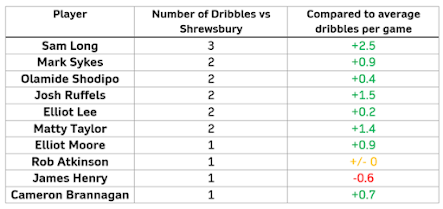Oxford did not dismantle Shrewsbury in the way they had Crewe four days earlier, but it was another impressive performance which reinforced the horrible feeling that Oxford could still creep into the playoffs.
It has so often been the hope that kills you this season.
Yet, for Oxford right now, it appears to be the hope that drives them
on.
Having been seemingly out of the playoff chase following
defeats to Sunderland and Accrington, the pressure was off.
Oxford played with freedom, energy and positivity. They
played with hope not expectation.
Robinson’s men still feel like outsiders for the playoffs, despite technically sitting only one place outside them.
Though their recent willingness
to try beating a man, or play forward passes and drive in behind teams is
certainly something they should look to carry into their remaining games and
beyond.
Every outfield player to play at least fifteen minutes for
Oxford attempted at least one dribble against Shrewsbury, amounting to a total
of 18 all game – particularly impressive given Barker went off early (though he
still managed one in his six minutes on the field).
There was a notable increase in willingness to carry the
ball forward and the fact every defender averaged at least one dribble
indicates Oxford’s confidence when building from the back.
Oxford also attempted 531 passes – 343 (64%) of which were
forward – as they were confident on the ball, contributing to their total of
60% possession, 7% higher than their season average.
It was similar in their thrashing of Crewe, registering 56% possession,
552 passes and 20 dribbles – eight of which came from midfield, the joint
highest number since McGuane’s injury nearly two months ago.
After a shaky start, it was clear United took that
confidence through into this game.
Shrewsbury, like many teams of late, looked to press Oxford’s
midfield, yet the belief in the middle thirds allowed Oxford to beat them and
create chance after chance for the forward line.
This (Below) is taken from just before the half hour mark.
As the ball drops to Brannagan from an Atkinson header, he
has two men pressing him. The easy ball is out to Ruffels, though he would then
be under pressure and likely be forced to clear it out of play.
Brannagan instead elects to use a sharp turn to shake off his markers and move into the pocket of space between Shrewsbury’s three-man midfield and wing backs.
This opened numerous passing lanes for Brannagan and took four Shrewsbury men out of the game.
This time, Brannagan overruns the ball, and it goes out for
a throw-in. Yet the confidence to take on his man opened up Shrewsbury and
created a four on five attacking scenario for Oxford had he picked the right
pass.
This continually happened, and Oxford repeatedly created
attacking scenarios through positive bursts in midfield, particularly from
Sykes, whose link up with Shodipo was also key to creating space.
Here, Shodipo collects the ball from Atkinson in the middle, interchanging with Sykes who has run in behind.
Shodipo’s first touch is a good one and he is immediately running forward before somewhat unconventionally beating two men…
and firing a ball out to Long on the wing.
Again, notice how the positive first touch and skill from
Shodipo takes more than half of Shrewsbury’s players out of the equation, and creates
a three against three scenario on the right hand side, whilst Sykes’ run in
behind allows Shodipo the time to turn in the middle.
The ball goes into the box and is cleared for a throw-in,
which Oxford then double their lead from.
In another example (Below), the combination between Sykes and Shodipo is present again, and this time it is Sykes who beats his man to create the opportunity.
It didn’t always have to be dribbling through the lines
either.
Look at this ball out from Atkinson, searching for the run of Sykes in behind.
Again, Shodipo drifts infield whilst Sykes runs behind the
backline to create space.
This ball doesn’t quite work, but the positivity from
Atkinson and movement from the midfield and wingers created headaches for
Shrewsbury all day who didn’t know whether to go with Shodipo or leave him to
collect the ball in midfield.
As we have seen in the examples above, Oxford found a way
through whatever they did.
The injury to Barker threatened to derail Oxford's game plan, but Shodipo offered a different kind of threat with his movement.
Oxford had the confidence to play balls forward quickly into Sykes and Shodipo, whilst the whole team showed more willingness to drive into spaces created by their movement.Crewe couldn’t handle it on Saturday and Shrewsbury’s three-man midfield were overrun by it on Tuesday.
Oxford are playing like a team reborn, with positive movement and forward touches creating attacking overloads which they are clinically exploiting.










Comments
Post a Comment